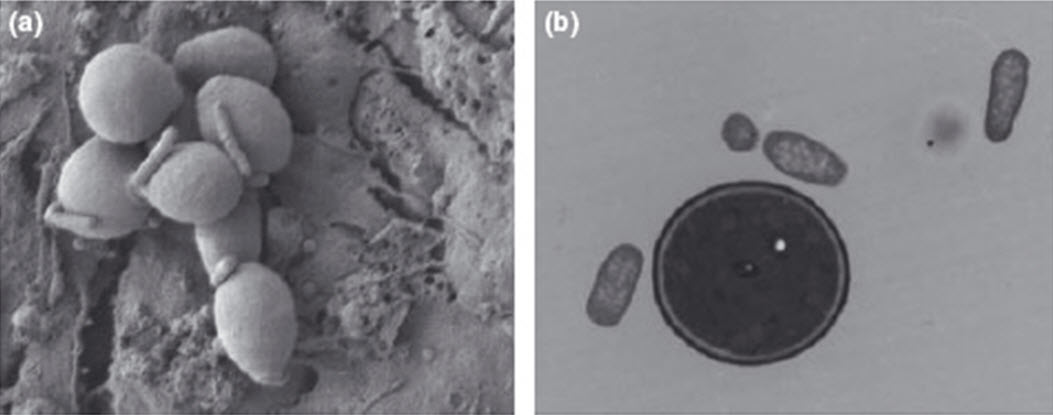ยีสต์โพรไบโอติก
Main Article Content
Abstract
Arun Chanchaichaovivat
รับบทความ: 16 พฤศจิกายน 2554; ยอมรับตีพิมพ์: 24 กุมภาพันธ์ 2555
บทคัดย่อ
โพรไบโอติก หมายถึง จุลินทรีย์ที่มีชีวิตเมื่อเข้าสู่ทางเดินอาหารของมนุษย์หรือสัตว์จะมีผลป้องกันหรือรักษาโรคติดเชื้อในระบบทางเดินอาหาร รวมทั้งส่งเสริมระบบภูมิคุ้มกันของร่างกายมนุษย์และสัตว์ โพรไบโอติกที่มีประสิทธิภาพควรมีสมบัติทนต่อสภาวะในทางเดินอาหารของผู้ให้อาศัย โดยไม่ถูกทำลายไป ยีสต์ที่ได้รับการพิสูจน์ว่าเป็นโพรไบโอติกที่ดีและผลิตเป็นการค้า คือ Saccharomyces boulardii ยีสต์ชนิดนี้ใช้ในการรักษาโรคท้องร่วงและความผิดปกติของระบบทางเดินอาหารของผู้ป่วยที่รับประทานยาปฏิชีวนะ การนำยีสต์มาผลิตเป็นอาหารโพรไบโอติมีข้อดีกว่าแบคทีเรียกลุ่มแลคทิก คือ ยีสต์สามารถดำรงชีวิตอยู่ได้ในสภาพแวดล้อมที่มีค่าความเป็นกรด-เบสได้หลายช่วง ทนต่อเอนไซม์ น้ำดีในทางเดินอาหาร และทนต่ออุณภูมิในร่างกายของผู้ให้อาศัย นอกจากนี้ยีสต์ไม่ทำให้เกิดการถ่ายทอดยีนดื้อยาปฏิชีวนะเข้าสู่แบคทีเรียก่อโรค การใช้ยีสต์โพรไบโอติกจึงปลอดภัยสำหรับผู้ป่วยที่อยู่ในระหว่างการได้รับยาปฏิชีวนะ กลไกการต่อต้านของยีสต์โพรไบโอติกต่อแบคทีเรียก่อโรคในทางเดินอาหารแบ่งได้เป็น 2 แบบ คือ การถอนพิษจากแบคทีเรีย และการเปลี่ยนแปลงการรับสัญญาณของเซลล์ผู้ให้อาศัย
คำสำคัญ: ยีสต์โพรไบโอติก ยีนดื้อยาปฏิชีวนะ ระบบทางเดินอาหาร ระบบภูมิคุ้มกัน Saccharomyces boulardii
Abstract
Probiotics are viable microorganisms caused beneficial effect when they enter to human or animal guts by prevention and treatment of enteric pathogens. Moreover, they can activate local mucosal protective mechanisms and modulate the immune system. Effective probiotics should tolerate and survive in gut conditions. Saccharomyces boulardii is commercial yeast probiotic that has been proven effective. This yeast has been accepted as therapeutic agent for preventing diarrhea and other GI disorders caused by the administration of antimicrobial agents. Using yeast as probiotic has better functions than those lactic bacteria, which it can grow in various pH and it tolerates to GI enzymes, bile salts, and temperature of host. In addition, no transferring of antibiotic resistant gene occurs between bacteria and yeast making yeast safe for use during antibiotic treatment. Yeast probiotic represent inhibitory effects against enteropathogenic bacteria by two mechanisms: (i) production of factors neutralized bacterial toxins and (ii) modulation of the host cell signaling pathway of proinflammatory response during bacterial infection.
Keywords: Yeast probiotics, Antibiotic resistant gene, Gut, Immune system, Saccharomyces boulardii
Downloads
Article Details

This work is licensed under a Creative Commons Attribution-NonCommercial 4.0 International License.
References
Berg, R. D. (1996). The indigenous gastrointestinal microflora. Trends Microbiol. 430: 435.
Clancy, R. (2003). Immunobiotics and the probiotic evolution. FEMS Immunol. Med. Microbiol. 38: 9–12.
Czerucka, D., Piche, T., and Rampal, P. (2007). Review article: yeast as probiotic-Saccharomyces boulardii. Aliment. Pharmacol. Ther. 26: 767-778.
Dalmasso, G., Loubat, A., Dahan, S., Dalmasso, G., Loubat, A., Dahan, S., Calle, G., Rampal, P., and Czerucka, D. (2006). Saccharomyces boulardii prevents TNFa-induced apoptosis in EHEC-infected T84 cells. Res. Microbiol. 157: 456–66.
Hennequin, C., Kauffmann-Lacroix, C., Jobert, A., Viard, J. P., Ricour, C., Jacquemin, J. L., and Berche, P. (2000). Possible role of catheters in Saccharomyces boulardii fungemia. Eur. J. Clin. Microbiol. Infect. Dis. 19: 16–20.
Janeway, C. A., and Medzhitov, R.. (2002). Innate immune recognition. Annu. Rev. Immunol. 20: 197–216.
Mathur, S., and Singh, R. (2005). Antibiotic resistance in food lactic acid bacteria: A review. Int. J. Food Microbiol. 105: 281–95.
Merrifield, D. L., Dimitroglou, A., Foey, A., Davies, S. J., Baker, T. M. R., Bøgwald, J., Castex, M., and Ringø, E. (2010). The current status and future focus of probiotic and prebiotic applications for salmonids. Aquaculture 302: 1-18.
Perapoch, J., Planes, A.M., Querol, A., López, V., Martínez-Bendayán, I., Tormo, R., Fernández, F., Peguero, G., and Salcedo, S. (2000). Fungemia with Saccharomyces cerevisiae in two newborns, only one of whom had been treated with Ultra-Levura. Eur. J. Clin. Microbiol. Infect. Dis. 19: 468–70.
Peterson, M. (2008). Saccharomyces boulardii - the yeast probiotic: probiotic yeast with health benefits for the gut flora. Retrieved November 28, 2010, from http:// melissa-peterson.suite101.com/saccharomyces-boulardiithe-yeast-probiotic-a84602
Temmerman, R., Pot, B., Huys, G., and Swings, J. (2003). Identification and antibiotic susceptibility of bacterial isolates from probiotic products. Int. J. Food Microbiol. 81: 1–10.
Waché, Y. Auffray, F.,Gatesoupe, F. J., Zambonino, J., Gayet, V., Labbé, L., and Quentel, C. (2006). Cross effects of the strain of dietary Saccharomyces cerevisiae and Rearing condition on the on set of intestinal microbiota and digestive enzymes in rainbow trout, Onchorhynchus mykiss, fry. Aquacuture 258: 470-478.
